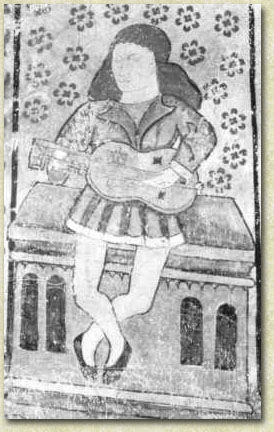Man playing a vihuela de mano. Anon fresco, c. 1514
(1514/ca) - Edebo Church in Uppland, Sweden
instrument: vihuela de mano | century: 16cent/1/early | catalogue nº: 16-168

Artwork
Creator anon
Medium Artwork: Painting
Location
City Edebo | Region Sweden | Old kingdom Sweden
Characteristics
| Body Waisted | Strings strings | Neck Short | Pegbox R/Angled flat |
| Bridge Button | Frets Unclear | Back Flat | Pegs Unclear |
| Technique Plucked fingers thumb in |
Commentary
ARTWORK
Painting in the Edebo Church in Uppland, dated c. 1514, according to Kenneth Sparr. The Wikipedia entry for this church says that the frescoes are from the 16th century and that they were restored when the church was renoavted in 1911-1913 (https://en.wikipedia.org/wiki/Edebo_Church, accessed 9/05/2020)
INSTRUMENT
A wide-bodied waisted vihuela, with a visible tailpiece but no visible bridge or soundhole, but decorations on the soundboard that may be soundholes. Indeterminate number of strings being plucked with the fingers (thumb under).
Sparr says that while the lute was known in Sweden as early as in the beginning of the 15th century the same cannot be said about the guitar. He indicates that it was fairly unknown until the 19th century, despite a few scattered references. This painting in the Edebo church in Uppland that can be dated 1514, obviously a vihuela da mano is therefore unusual. He cautions that the artists may have used a model from abroad. He adds: “There are some odd things about the instrument: the lack of a central soundhole, the bent-back pegbox and the fact that the strings are attached to the lower end of the body. The bent-back pegbox, however, is not unique to our instrument. You may find the same in the famous engraving by Marcantonio Raimondi of a man playing a five-course vihuela or viola da mano. As a matter of fact this engraving is contemporary with the one in the Edebo church.”
This instrument is catalogued by RIDIM https://db.ridim.org/item/186